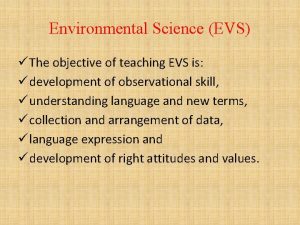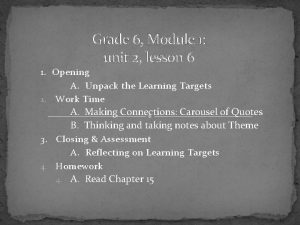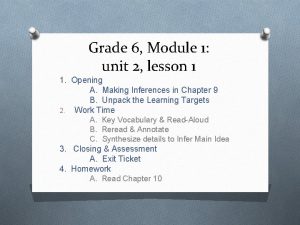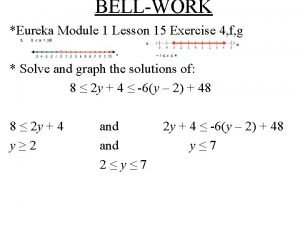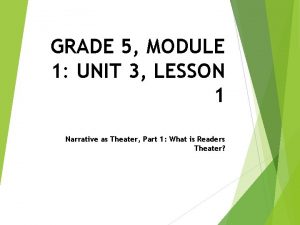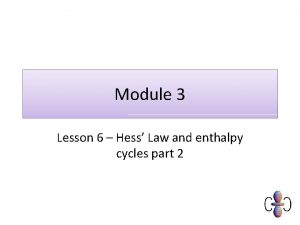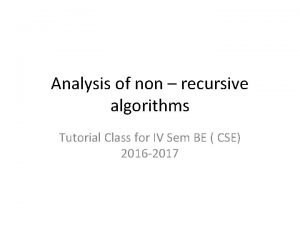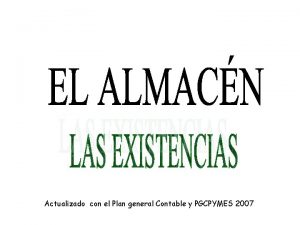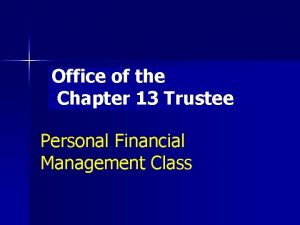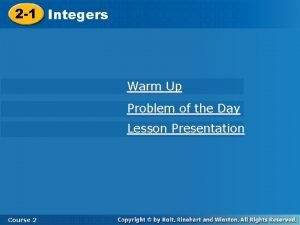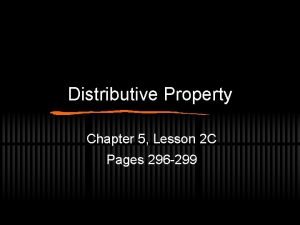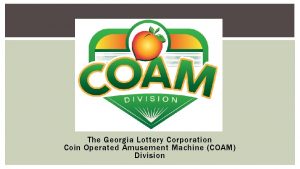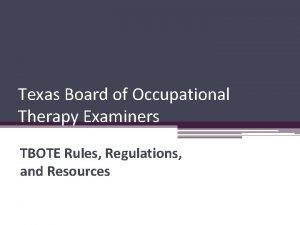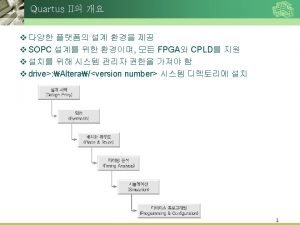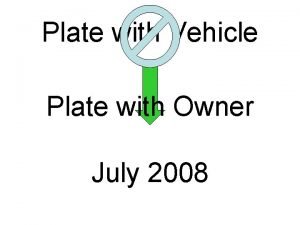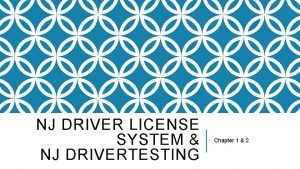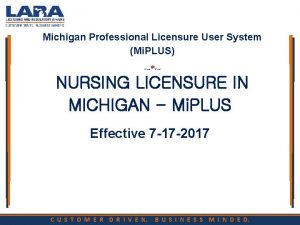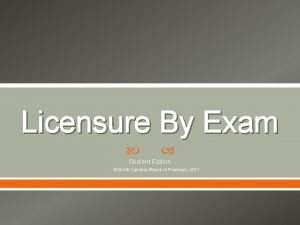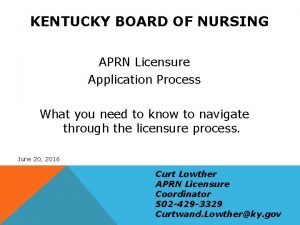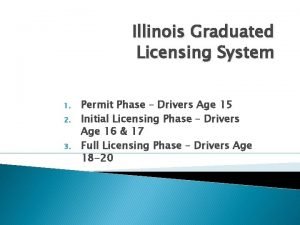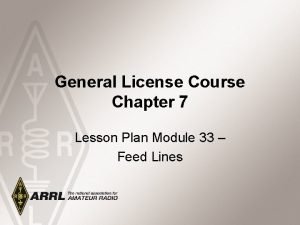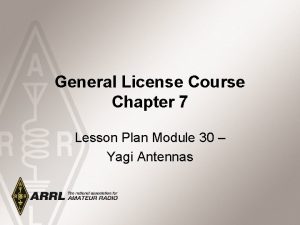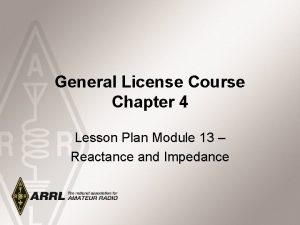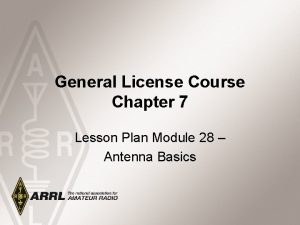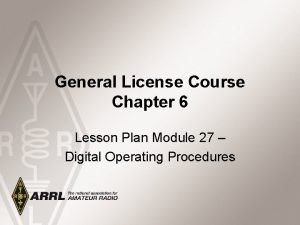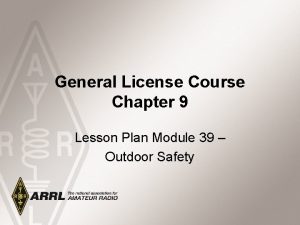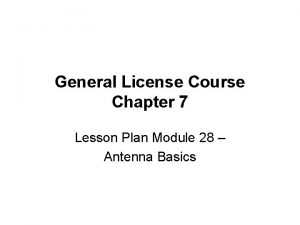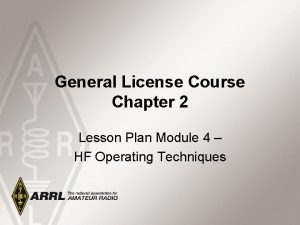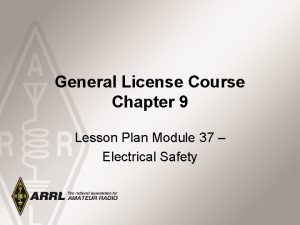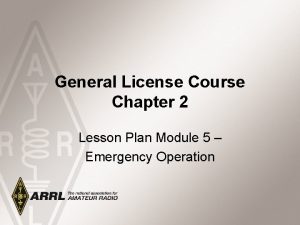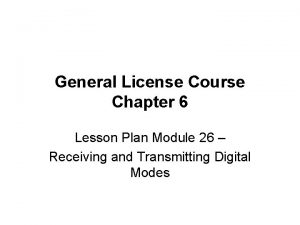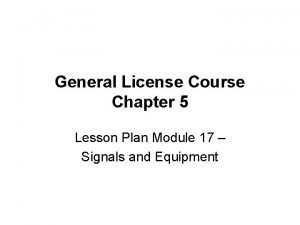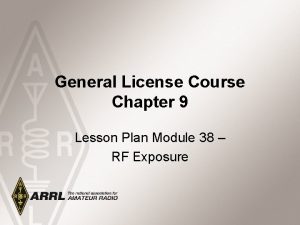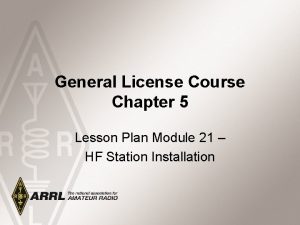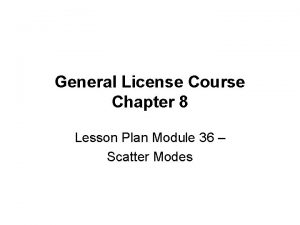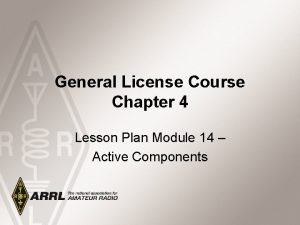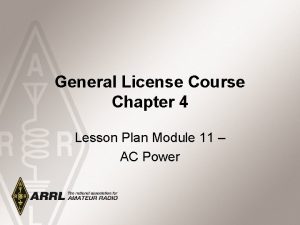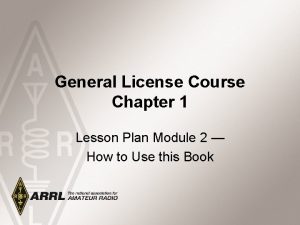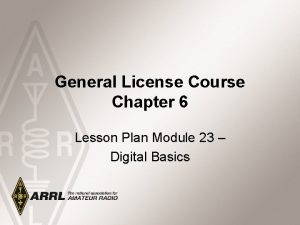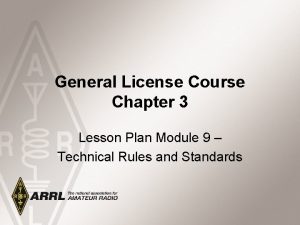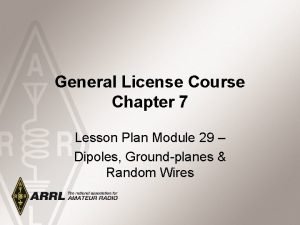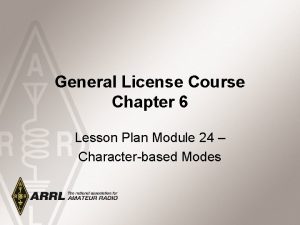General License Course Chapter 4 Lesson Plan Module


































































- Slides: 66

General License Course Chapter 4 Lesson Plan Module 15 – Practical Circuits

Rectifiers • Half-wave rectifier allows current to flow in one-half of the input ac waveform (180°) from the transformer, as shown in “A” • Full-wave centertrapped rectifier two half-wave rectifiers operating on alternating half cycles, as shown in “B”, using the transformer center tap for the current’s return path 2015 General License Course 2

Rectifiers • Full Wave Rectifier Circuits • Advantage – output is produced during entire 360° of the ac cycle • Output is a series of pulses at twice the frequency of the input voltage • Full-wave bridge rectifier – uses a pair of diodes on alternating ac cycle halves 2015 General License Course 3

Rectifiers • Full-wave bridge rectifier • Diodes only have to withstand the full supply output voltage • Each diode carries the full load current. 2015 General License Course 4

Rectifiers • Peak inverse voltage in a half-wave rectifier is twice the supply output voltage • Half-wave rectifier – the entire load current goes through one diode 2015 General License Course 5

Filter Circuits • Rectifier’s pulsed output is unusable as dc • Filter networks – made up of capacitors and inductors, smooth out the ripple • Common method to smooth the ripple in a linear supply is a large electrolytic capacitor • Regulation – the percent variation in output voltage between no load and full load • Inductor-input or choke-input – uses an inductor to smooth current pulses with a capacitor so smooth voltage. 2015 General License Course 6

Power Supplies • Power supply safety: • Fuses in the primary are used to protect against short circuits or excessive current • Bleeder resistors discharge stored energy when the supply is turned off • Working on power supplies – wait for the bleeder resistor to discharge energy, even if it is unplugged 2015 General License Course 7

Power Supplies • Switching or Switchmode supplies: • Transistors switch current pulses at a high frequency (20 k. Hz or more) through a transformer and/or inductor then a capacitor filters the voltage • The high frequency allows lightweight inductors and transformers to be used • Linear supplies are very heavy due to their large, iron-core power transformer 2015 General License Course 8

Batteries • Large marine or RV storage batteries are often used as emergency backup power supplies • Liquid-electrolyte or gel-electrolyte batteries are rated at 12 V but should be maintained at 13. 8 V • Lead-acid batteries are useful until their output drops to 10. 5 V • Discharging batteries past their minimum voltage will reduce the life of the battery 2015 General License Course 9

Batteries 2015 General License Course 10

Batteries • Ni. Cds (or Nicads) – designed to have low internal resistance to supply high discharge currents for tools and transmitters • Battery self-discharge gradually reduces stored energy over time • Slow by storage in a cool and dry place • Freezing will damage batteries with liquid or gel electrolytes 2015 General License Course 11

Charging Batteries • Different types of batteries require different charging methods • Use the proper type of charger to maximize the life and usefulness of the battery • Never attempt to recharge a carbon-zinc, alkaline, or silver-nickel type battery (chemical reaction can not be reversed) 2015 General License Course 12

Alternative Power • Solar Power – photovoltaic conversion of sunlight directly to electricity • Solar cells are a special type of diode • The forward voltage created as the electrons cross the junction is approximately 0. 5 V dc (open circuit voltage) • Individual solar cells can be connected in series to create higher voltages (24 cells to create 12 V) • Wind generators use dc generators connected to propellers that spin them 2015 General License Course 13

Energy Storage • Wind and solar power require a substantial energy storage system • No wind or sun means no power • Excess power needs to be stored during peak periods of generation (batteries are the most common method) • Diodes prevent the batteries from discharging back through the solar panels 2015 General License Course 14

Connectors • Keyed connectors only mate one way, reducing the possibility of damage • Plugs are installed on cables • Jacks are installed on equipment • Adaptors make connections between different style connectors • Splitters divide a signal between two connectors 2015 General License Course 15

Power Connectors Anderson Powerpole® connectors have become the standard for radio equipment used by ARES 2015 General License Course 16

Audio Connectors • Consumer electronics and Amateur Radio share many of the same connectors 2015 General License Course 17

Audio Connectors • Contact tip is the end of the plug • The sleeve is the base of the plug • The ring is a third contact between the tip and sleeve • Phono plugs are often called RCA connectors (commonly used for audio signals) • DIN or mini-DIN connectors are keyed and have up to 9 pins and are used to control multiple circuits on radio equipment 2015 General License Course 18

RF Connectors 2015 General License Course 19

RF Connectors • Special RF feed line connectors: • UHF connectors (SO-239 & PL-259) can be used up to 150 MHz • “N” connectors are moisture resistant and used up to 10 GHz • SMA connectors are small threaded connectors designed for miniature coaxial cable and are rated up to 18 GHz • Used on many hand-held radios 2015 General License Course 20

Data Connectors • Digital data is exchanged between the computers and amateur radios: • D-type connectors are used for RS-232 (COM ports) and parallel ports • D-type 9 -pin connector is referred to as DB-9 or DE-9 (commonly used for serial ports) • 25 -pin D-type connector for parallel ports • USB ports are standard for current computers 2015 General License Course 21

Practice Questions 2015 General License Course

What is the name of the process by which sunlight is changed directly into electricity? A. Photovoltaic conversion B. Photon emission C. Photosynthesis D. Photon decomposition G 4 E 08 2015 General License Course

What is the name of the process by which sunlight is changed directly into electricity? A. Photovoltaic conversion B. Photon emission C. Photosynthesis D. Photon decomposition G 4 E 08 2015 General License Course

What is the approximate open-circuit voltage from a fully illuminated silicon photovoltaic cell? A. 0. 02 VDC B. 0. 5 VDC C. 0. 2 VDC D. 1. 38 VDC G 4 E 09 2015 General License Course

What is the approximate open-circuit voltage from a fully illuminated silicon photovoltaic cell? A. 0. 02 VDC B. 0. 5 VDC C. 0. 2 VDC D. 1. 38 VDC G 4 E 09 2015 General License Course

What is the reason that a series diode is connected between a solar panel and a storage battery that is being charged by the panel? A. The diode serves to regulate the charging voltage to prevent overcharge B. The diode prevents self-discharge of the battery though the panel during times of low or no illumination C. The diode limits the current flowing from the panel to a safe value D. The diode greatly increases the efficiency during times of high illumination G 4 E 10 2015 General License Course

What is the reason that a series diode is connected between a solar panel and a storage battery that is being charged by the panel? A. The diode serves to regulate the charging voltage to prevent overcharge B. The diode prevents self-discharge of the battery though the panel during times of low or no illumination C. The diode limits the current flowing from the panel to a safe value D. The diode greatly increases the efficiency during times of high illumination G 4 E 10 2015 General License Course

Which of the following is a disadvantage of using wind as the primary source of power for an emergency station? A. The conversion efficiency from mechanical energy to electrical energy is less than 2 percent B. The voltage and current ratings of such systems are not compatible with amateur equipment C. A large energy storage system is needed to supply power when the wind is not blowing D. All of these choices are correct G 4 E 11 2015 General License Course

Which of the following is a disadvantage of using wind as the primary source of power for an emergency station? A. The conversion efficiency from mechanical energy to electrical energy is less than 2 percent B. The voltage and current ratings of such systems are not compatible with amateur equipment C. A large energy storage system is needed to supply power when the wind is not blowing D. All of these choices are correct G 4 E 11 2015 General License Course

What is the minimum allowable discharge voltage for maximum life of a standard 12 volt lead acid battery? A. 6 volts B. 8. 5 volts C. 10. 5 volts D. 12 volts G 6 A 01 2015 General License Course

What is the minimum allowable discharge voltage for maximum life of a standard 12 volt lead acid battery? A. 6 volts B. 8. 5 volts C. 10. 5 volts D. 12 volts G 6 A 01 2015 General License Course

What is an advantage of the low internal resistance of nickel-cadmium batteries? A. Long life B. High discharge current C. High voltage D. Rapid recharge G 6 A 02 2015 General License Course

What is an advantage of the low internal resistance of nickel-cadmium batteries? A. Long life B. High discharge current C. High voltage D. Rapid recharge G 6 A 02 2015 General License Course

When is it acceptable to recharge a carbon-zinc primary cell? A. As long as the voltage has not been allowed to drop below 1. 0 volt B. When the cell is kept warm during the recharging period C. When a constant current charger is used D. Never G 6 A 04 2015 General License Course

When is it acceptable to recharge a carbon-zinc primary cell? A. As long as the voltage has not been allowed to drop below 1. 0 volt B. When the cell is kept warm during the recharging period C. When a constant current charger is used D. Never G 6 A 04 2015 General License Course

Which of the following connectors would be a good choice for a serial data port? A. PL-259 B. Type N C. Type SMA D. DE-9 G 6 B 12 2015 General License Course

Which of the following connectors would be a good choice for a serial data port? A. PL-259 B. Type N C. Type SMA D. DE-9 G 6 B 12 2015 General License Course

Which of these connector types is commonly used for RF connections at frequencies up to 150 MHz? A. Octal B. RJ-11 C. PL-259 D. DB-25 G 6 B 13 2015 General License Course

Which of these connector types is commonly used for RF connections at frequencies up to 150 MHz? A. Octal B. RJ-11 C. PL-259 D. DB-25 G 6 B 13 2015 General License Course

Which of these connector types is commonly used for audio signals in Amateur Radio stations? A. PL-259 B. BNC C. RCA Phono D. Type N G 6 B 14 2015 General License Course

Which of these connector types is commonly used for audio signals in Amateur Radio stations? A. PL-259 B. BNC C. RCA Phono D. Type N G 6 B 14 2015 General License Course

What is the main reason to use keyed connectors instead of non-keyed types? A. Prevention of use by unauthorized persons B. Reduced chance of incorrect mating C. Higher current carrying capacity D. All of these choices are correct G 6 B 15 2015 General License Course

What is the main reason to use keyed connectors instead of non-keyed types? A. Prevention of use by unauthorized persons B. Reduced chance of incorrect mating C. Higher current carrying capacity D. All of these choices are correct G 6 B 15 2015 General License Course

Which of the following describes a type N connector? A. A moisture-resistant RF connector useful to 10 GHz B. A small bayonet connector used for data circuits C. A threaded connector used for hydraulic systems D. An audio connector used in surround-sound installations G 6 B 16 2015 General License Course

Which of the following describes a type N connector? A. A moisture-resistant RF connector useful to 10 GHz B. A small bayonet connector used for data circuits C. A threaded connector used for hydraulic systems D. An audio connector used in surround-sound installations G 6 B 16 2015 General License Course

What is the general description of a DIN type connector? A. A special connector for microwave interfacing B. A DC power connector rated for currents between 30 and 50 amperes C. A family of multiple circuit connectors suitable for audio and control signals D. A special watertight connector for use in marine applications G 6 B 17 2015 General License Course

What is the general description of a DIN type connector? A. A special connector for microwave interfacing B. A DC power connector rated for currents between 30 and 50 amperes C. A family of multiple circuit connectors suitable for audio and control signals D. A special watertight connector for use in marine applications G 6 B 17 2015 General License Course

What is a type SMA connector? A. A large bayonet connector usable at power levels in excess of 1 KW B. A small threaded connector suitable for signals up to several GHz C. A connector designed for serial multiple access signals D. A type of push-on connector intended for high voltage applications G 6 B 18 2015 General License Course

What is a type SMA connector? A. A large bayonet connector usable at power levels in excess of 1 KW B. A small threaded connector suitable for signals up to several GHz C. A connector designed for serial multiple access signals D. A type of push-on connector intended for high voltage applications G 6 B 18 2015 General License Course

What useful feature does a power supply bleeder resistor provide? A. It acts as a fuse for excess voltage B. It ensures that the filter capacitors are discharged when power is removed C. It removes shock hazards from the induction coils D. It eliminates ground loop current G 7 A 01 2015 General License Course

What useful feature does a power supply bleeder resistor provide? A. It acts as a fuse for excess voltage B. It ensures that the filter capacitors are discharged when power is removed C. It removes shock hazards from the induction coils D. It eliminates ground loop current G 7 A 01 2015 General License Course

Which of the following components are used in a power supply filter network? A. Diodes B. Transformers and transducers C. Quartz crystals D. Capacitors and inductors G 7 A 02 2015 General License Course

Which of the following components are used in a power supply filter network? A. Diodes B. Transformers and transducers C. Quartz crystals D. Capacitors and inductors G 7 A 02 2015 General License Course

What is the peak-inverse-voltage across the rectifiers in a full-wave bridge power supply? A. One-quarter the normal output voltage of the power supply B. Half the normal output voltage of the power supply C. Double the normal peak output voltage of the power supply D. Equal to the normal peak output voltage of the power supply G 7 A 03 2015 General License Course

What is the peak-inverse-voltage across the rectifiers in a full-wave bridge power supply? A. One-quarter the normal output voltage of the power supply B. Half the normal output voltage of the power supply C. Double the normal peak output voltage of the power supply D. Equal to the normal peak output voltage of the power supply G 7 A 03 2015 General License Course

What is the peak-inverse-voltage across the rectifier in a half-wave power supply? A. One-half the normal peak output voltage of the power supply B. One-half the normal output voltage of the power supply C. Equal to the normal output voltage of the power supply D. Two times the normal peak output voltage of the power supply G 7 A 04 2015 General License Course

What is the peak-inverse-voltage across the rectifier in a half-wave power supply? A. One-half the normal peak output voltage of the power supply B. One-half the normal output voltage of the power supply C. Equal to the normal output voltage of the power supply D. Two times the normal peak output voltage of the power supply G 7 A 04 2015 General License Course

What portion of the AC cycle is converted to DC by a half-wave rectifier? A. 90 degrees B. 180 degrees C. 270 degrees D. 360 degrees G 7 A 05 2015 General License Course

What portion of the AC cycle is converted to DC by a half-wave rectifier? A. 90 degrees B. 180 degrees C. 270 degrees D. 360 degrees G 7 A 05 2015 General License Course

What portion of the AC cycle is converted to DC by a full-wave rectifier? A. 90 degrees B. 180 degrees C. 270 degrees D. 360 degrees G 7 A 06 2015 General License Course

What portion of the AC cycle is converted to DC by a full-wave rectifier? A. 90 degrees B. 180 degrees C. 270 degrees D. 360 degrees G 7 A 06 2015 General License Course

What is the output waveform of an unfiltered full -wave rectifier connected to a resistive load? A. A series of DC pulses at twice the frequency of the AC input B. A series of DC pulses at the same frequency as the AC input C. A sine wave at half the frequency of the AC input D. A steady DC voltage G 7 A 07 2015 General License Course

What is the output waveform of an unfiltered full -wave rectifier connected to a resistive load? A. A series of DC pulses at twice the frequency of the AC input B. A series of DC pulses at the same frequency as the AC input C. A sine wave at half the frequency of the AC input D. A steady DC voltage G 7 A 07 2015 General License Course

Which of the following is an advantage of a switchmode power supply as compared to a linear power supply? A. Faster switching time makes higher output voltage possible B. Fewer circuit components are required C. High frequency operation allows the use of smaller components D. All of these choices are correct G 7 A 08 2015 General License Course

Which of the following is an advantage of a switchmode power supply as compared to a linear power supply? A. Faster switching time makes higher output voltage possible B. Fewer circuit components are required C. High frequency operation allows the use of smaller components D. All of these choices are correct G 7 A 08 2015 General License Course
 Micro teaching lesson plan for english
Micro teaching lesson plan for english Objective of evs
Objective of evs C device module module 1
C device module module 1 Front line leadership definition
Front line leadership definition Course module sample
Course module sample Lesson plan of a gift of chappals
Lesson plan of a gift of chappals Cut brick lengthwise
Cut brick lengthwise Course number and title
Course number and title Course interne course externe
Course interne course externe Adjutant general captains career course
Adjutant general captains career course If a student driver commits a traffic violation
If a student driver commits a traffic violation Chapter 1 the new jersey driver license system answers
Chapter 1 the new jersey driver license system answers Chapter 1 the new jersey driver license system answers
Chapter 1 the new jersey driver license system answers Chapter 1 lesson 1 your total health answer key
Chapter 1 lesson 1 your total health answer key Lesson 3 a new plan of government answer key
Lesson 3 a new plan of government answer key Diferencia entre gran plano general y plano general
Diferencia entre gran plano general y plano general Where did general lee surrender to general grant?
Where did general lee surrender to general grant? Hardship and suffering lesson 2
Hardship and suffering lesson 2 Module 5 lesson 5
Module 5 lesson 5 Grade 8 module 1 unit 1 lesson 6 answer key
Grade 8 module 1 unit 1 lesson 6 answer key Practical/logistical issues in relationships
Practical/logistical issues in relationships Grade 6 module
Grade 6 module Module eleven lesson one self check quiz
Module eleven lesson one self check quiz Eureka math algebra 1 module 1 lesson 15
Eureka math algebra 1 module 1 lesson 15 Grade 5 module 1 lesson 1
Grade 5 module 1 lesson 1 Module 15 lesson 1 central angles and inscribed angles
Module 15 lesson 1 central angles and inscribed angles Module 3 lesson 6
Module 3 lesson 6 Course plan ppt
Course plan ppt Estructura del plan contable
Estructura del plan contable Vessel general arrangement
Vessel general arrangement General cargo stowage plan
General cargo stowage plan National general benefits solutions providers
National general benefits solutions providers Non recursive algorithm
Non recursive algorithm Describe the schlieffen plan
Describe the schlieffen plan Plan general contable actualizado
Plan general contable actualizado Course 2 chapter 1 ratios and proportional reasoning
Course 2 chapter 1 ratios and proportional reasoning Steve wyborney
Steve wyborney Chapter 13 personal financial management course
Chapter 13 personal financial management course Course 2 chapter 3 integers
Course 2 chapter 3 integers Lesson 2 the distributive property
Lesson 2 the distributive property Esti mysteries kindergarten
Esti mysteries kindergarten Work based learning license mn
Work based learning license mn Wisconsin ems licensing
Wisconsin ems licensing Cssm cisco
Cssm cisco The lightning thief activities
The lightning thief activities Ga coam
Ga coam Tbote rules
Tbote rules Spla usage report
Spla usage report Altera quartus 2 web edition
Altera quartus 2 web edition Michigan raffle license application
Michigan raffle license application Temporary license plate south dakota
Temporary license plate south dakota Nurse practice act oregon
Nurse practice act oregon Omma complaint
Omma complaint Basic driver's license nj
Basic driver's license nj Graduated drivers license nj
Graduated drivers license nj Sap licensing negotiation
Sap licensing negotiation Nc dmv license and theft
Nc dmv license and theft Www.michigan.gov/miplus
Www.michigan.gov/miplus South carolina board of pharmacy license renewal
South carolina board of pharmacy license renewal Ptal california medical board
Ptal california medical board Kofax vrs administration console
Kofax vrs administration console Kentucky board of nursing application status
Kentucky board of nursing application status Taxi license finland
Taxi license finland Sas license cost
Sas license cost During the initial licensing phase
During the initial licensing phase Hid mobile portal
Hid mobile portal Pesticide warning signs ontario
Pesticide warning signs ontario

